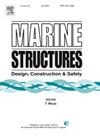Artificial neural network model to assist in design of ship stiffened plates considering ultimate strength
IF 5.1
2区 工程技术
Q1 ENGINEERING, CIVIL
引用次数: 0
Abstract
The ship structure is exposed to combined loading conditions during operational exposure to waves due to the hull weight, cargo weight, and other loads. Because the primary structural members of the ship structure are stiffened plates, securing structural safety during the ship design stage is critical. However, in the current design method, the results are inaccurate and inefficient in terms of the required time or cost owing to the poor preparation of the physical model or assumptions regarding the boundary conditions. To resolve this, the present study performs a structural analysis on 3000 stiffened plates with included initial imperfections and subjected to axial compression, which causes the buckling loads on the ship. Deep learning database is constructed based on the finite element analysis results. Then, deep learning model is developed to propose an effective method for predicting the ultimate strength of the stiffened plates. The prediction results of the deep learning method showed similarity with the FE analysis results. During the initial design stage, the structural designer can use this model to determine the geometrical properties of the stiffened plate within a reasonable time and cost. In addition, these results can potentially be used in the reverse engineering of vessels.
考虑极限强度的船舶加筋板设计中的人工神经网络模型
由于船体重量、货物重量和其他载荷的影响,船舶结构在操作过程中暴露于波浪的组合载荷条件下。由于船舶结构的主要结构构件是加劲板,因此在船舶设计阶段确保结构的安全至关重要。然而,在目前的设计方法中,由于物理模型的准备或对边界条件的假设不充分,在所需的时间或成本方面,结果是不准确和低效的。为了解决这个问题,本研究对3000块加筋板进行了结构分析,其中包括初始缺陷,并受到轴向压缩,这导致了船舶的屈曲载荷。基于有限元分析结果构建深度学习数据库。在此基础上,建立了深度学习模型,提出了一种预测加筋板极限强度的有效方法。深度学习方法的预测结果与有限元分析结果相似。在初始设计阶段,结构设计人员可以利用该模型在合理的时间和成本内确定加筋板的几何性能。此外,这些结果可以潜在地用于船舶的逆向工程。
本文章由计算机程序翻译,如有差异,请以英文原文为准。
求助全文
约1分钟内获得全文
求助全文
来源期刊

Marine Structures
工程技术-工程:海洋
CiteScore
8.70
自引率
7.70%
发文量
157
审稿时长
6.4 months
期刊介绍:
This journal aims to provide a medium for presentation and discussion of the latest developments in research, design, fabrication and in-service experience relating to marine structures, i.e., all structures of steel, concrete, light alloy or composite construction having an interface with the sea, including ships, fixed and mobile offshore platforms, submarine and submersibles, pipelines, subsea systems for shallow and deep ocean operations and coastal structures such as piers.
 求助内容:
求助内容: 应助结果提醒方式:
应助结果提醒方式:


